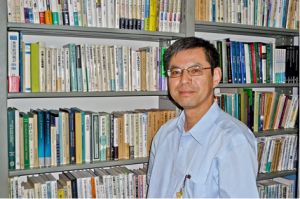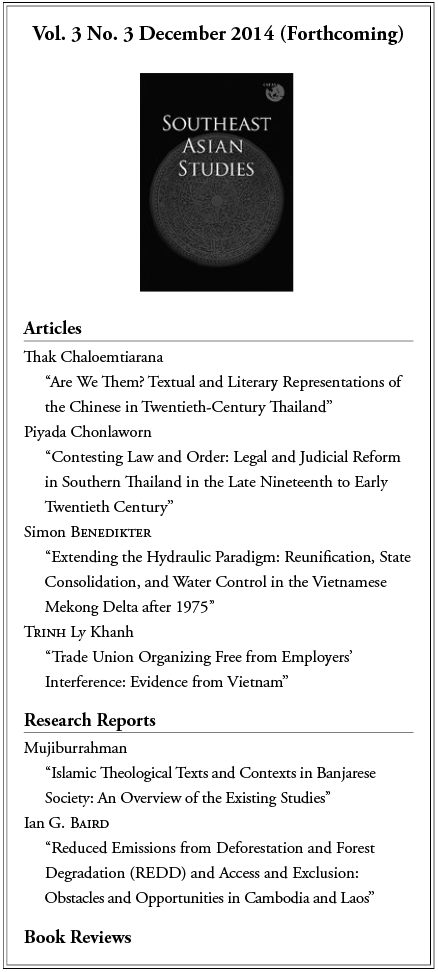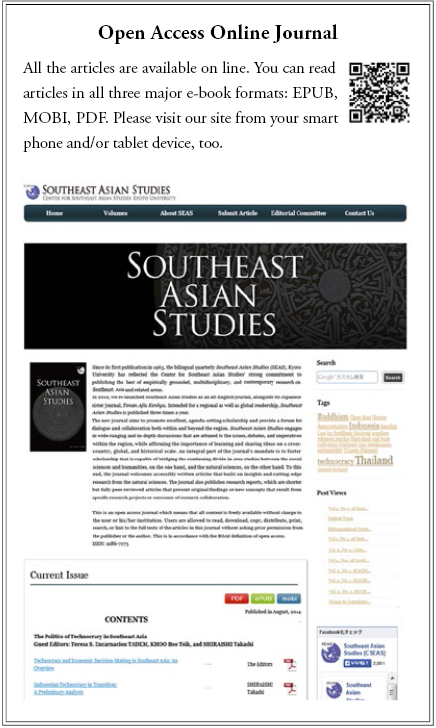Interview with Fujita Koichi
Chief Editor of Southeast Asian Studies (SEAS)
CSEAS launched an all-English academic journal, Southeast Asian Studies as a sister journal of Tonan Ajia Kenkyu which had been published as a bilingual quarterly journal since 1963. Southeast Asian Studies aims to promote excellent, agenda-setting scholarship and provide a forum for dialogue and collaboration both within and beyond the region. Since 2012, 43 articles, 2 research reports, and 71 book reviews have been included. The journal has also published three special issues and one special focus: De-institutionalizing Religion in Southeast Asia, edited by Kataoka Tatsuki (Vol. 1, No. 3); Upland Peoples in the Making of History in Northern Continental Southeast Asia, edited by Christian Daniels (Vol. 2, No. 1); Reconstructing Intra-Southeast Asian Trade, c.1780–1870: Evidence of Regional Integration under the Regime of Colonial Free Trade, edited by Sugihara Kaoru (special focus) (Vol. 2, No. 3); and The Politics of Technocracy in Southeast Asia, edited by Teresa S. Encarnacion Tadem, Khoo Boo Teik, and Shiraishi Takashi (Vol. 3, No. 2).
This spring, Professor Fujita Koichi took over the position of Chief Editor from Professor Caroline Sy. Hau who oversaw the transition period and its launch. Shitara Narumi, managing editor, interviews Professor Fujita to introduce the journal.
——. As part of the Center for Southeast Asian Studies’ (CSEAS) aim to internationalize and reach out to a larger international audience of scholars and academics engaged in Southeast Asian Studies, the Center launched a new English journal in 2012. What was the major impetus in creating this new international journal?
Fujita: Since 1963 CSEAS had been publishing our quarterly journal Tonan Ajia Kenkyu (Southeast Asian Studies) until 2011 (Vol. 49) with a total number of 199 issues. It’s not an exaggeration to say that Tonan Ajia Kenkyu had been a leading journal for Southeast Asian area studies in Japan as shown by the fact that it has been indexed in Scopus by Elsevier. However, although it was bilingual, accepting English articles along with Japanese ones, it never achieved a high level of popularity among foreign scholars including Southeast Asians, due to its format. As part of our Center’s drive to internationalize we decided to separate the previous journal and launch an all-English journal in 2012.
——. What are the journal’s main aims and perspectives?
Fujita: CSEAS has a distinctive characteristic that separates it from other similar research institutes in the world. Since its inception, it has been promoting multidisciplinary area studies for and within Southeast Asia, not only within the humanities and social sciences, but also the natural sciences. Such a characteristic is becoming more essential in today’s globalizing world where environmental issues jeopardize human life and survival. Of course, we recognize that achieving real multidisciplinary studies is no easy task, but we continue to constantly challenge ourselves to do it. In the medium and long term, we are eager to create a real multidisciplinary and highly qualified, innovative, and stimulating journal for Southeast Asian area studies.
——. The journal also welcomes Research Reports. Can you explain what is the distinction between articles and Research Reports and what kind of manuscripts does the committee expect authors to submit?
Fujita: Research Reports are shorter but fully peer-reviewed articles that present original findings from specific research projects or collaborative research outcomes. However, I must emphasize that Research Reports are not less-quality papers, inferior to articles. We expect Research Reports to present totally new and innovative ideas or hypotheses. CSEAS has a long tradition in field science. We believe that realities are much more complex and interesting than existing theories. Thus the aim is to create new theories from the ground through a birds’ eye view. We place more weight on unsophisticated but stimulating papers rather than sophisticated but conventional ones.
——. Looking back to the inaugural issue published in 1963, the very first article in Tonan Ajia Kenkyu offered a stimulating discussion on the definition of “area studies” within a Japanese context. Fifty years have passed since then and the field has evolved. How do you perceive present day area studies?
Fujita: Contrary to my expectations, the percentage of stimulating and innovative papers seems to be decreasing. There are many factors contributing to this which are beyond our control. But I believe that the raison d’être of CSEAS lies in providing new ideas and perspectives by breaking the barriers of existing disciplines. Area studies offer a good potential to such a necessary task in the present world and Japan.

Professor Fujita Koichi Chief Editor of Southeast Asian Studies
——. Could you offer some advice to scholars who plan to submit their articles to Southeast Asian Studies?
Fujita: So far I have emphasized the importance of academic innovativeness. We accept all kinds of manuscripts from all over the world, if they are related to Southeast Asian area studies. Please do not hesitate to submit your manuscripts to our new journal. By submitting your manuscripts to us you will receive high-quality feedback through our rigorous referee system. We look forward to all future submissions.


